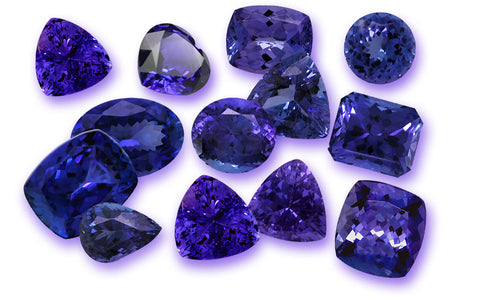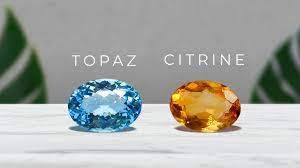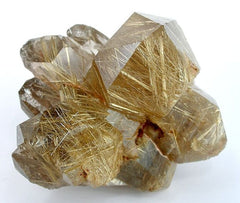Tanzanite: A December Birthstone
Nov 28 2017 0 Comments
 This month, Gemstones Brazil brings you a comprehensive fact sheet about the stunning, blue-violet tanzanite gemstone! As one of the December birthstones, this is the perfect gift for a December baby in your life!
This month, Gemstones Brazil brings you a comprehensive fact sheet about the stunning, blue-violet tanzanite gemstone! As one of the December birthstones, this is the perfect gift for a December baby in your life!
How did tanzanite get its name?
As you might have guessed, tanzanite gets its name from the African country Tanzania - this reflects its limited geographic origin. The only tanzanite deposit of commercial importance is in northern Tanzania, near the base of Mount Kilimanjaro.
'Tanzanite' is actually a trade name, first used by Tiffany and Co.; the company could have used the mineralogical name 'blue zoisite' instead, but they thought that 'tanzanite' sounded more appealing and would thus be easier to market.
The origins of tanzanite
As mentioned above, tanzanite is only found in one place on earth: in Tanzania, East Africa. The only known deposit is contained within a small mining area of around 7km by 2km - at a rate of 2.7 million carats a year, it is estimated that the mine will continue to be productive for around another thirty years before there is no tanzanite left to mine.
Tanzanite is a blue to violet gemstone (sometimes even burgundy-hued), which is a member of the zoisite mineral group. It was officially discovered only recently, in 1967: many accounts credit part-time gold prospector Manuel d'Souza with the discovery. He at first thought it was a kind of olivine crystal, but quickly realised that this was not the case. It is likely that d'Souza was alerted to the presence of the stones by Masai tribesmen from the area. Tanzanite was first mined from this deposit in 1967, and d'Souza confirmed that it was not an olivine stone or sapphire that he had found, but a new variety of zoisite.
Identifying tanzanite
Tanzanite is a beautiful stone, with a few strong distinguishing features:
- It is especially noted for its strong trichroism/pleochroism, meaning that the same stone can appear different colours depending on its orientation.
- It ranges from ultramarine to deep sapphire blue in colour, sometimes appearing violet or burgundy. It often has a brownish cast when in its rough form, and is almost always heat-treated to enhance its blue colour (treatment is so common that this doesn't have a bearing on value).
- It is most accurately identified by its refractive index and density.
- Its orthorhombic crystal system can distinguish it from similar gemstones, such as amethyst.
Gemological properties
Mineral: Zoisite
Chemistry: Ca2Al2(SiO4)3(OH)
Crystal System: Orthorhombic, multifaced prisms, mostly striated
Density/Specific Gravity: 3.35
Mohs Hardness: 6.5 to 7
Refractive Index: 1.691 to 1.700
Birefringence: 0.009
Buying tanzanite
Tanzanite, with its attractive ultramarine to sapphire blue colour, is a sought-after stone. The most desirable colour for tanzanite gemstones is a rich, saturated blue or violet-blue colour. The colour saturation tends to be higher in gemstones of more than 5 carats.
Eye-clean tanzanite can frequently be found, and should be sought by buyers. Eye-visible inclusions decrease value, with the exception of cat's eye tanzanite, which has desirable inclusions causing chatoyancy (cat's eye effect). This resembles the shining slit-eye of a cat.
Tanzanite is faceted in both traditional and fancy shapes, with a  variety of cutting styles. It is popular, given the cost, to cut tanzanite into oval and cushion shapes. Cat's eye tanzanite is cut en cabochon in order to display the chatoyancy to best effect. The main colour visible will depend on the orientation of the cut.
variety of cutting styles. It is popular, given the cost, to cut tanzanite into oval and cushion shapes. Cat's eye tanzanite is cut en cabochon in order to display the chatoyancy to best effect. The main colour visible will depend on the orientation of the cut.
As aforementioned, tanzanite is almost always heat-treated to reveal its true colour. Reputable gem traders will declare all treatments and enhancements, even if they are considered routine.
Gemstone care
Tanzanite has perfect cleavage, which means tanzanite gemstones and jewellery should be protected from hard blows that might cause breakage. Tanzanite is thus best worn in protected settings such as bezel, and should not be worn daily in less protected pronged settings.
Chemical and steam cleaners should not be used to clean tanzanite, as it is sensitive to heat and acid: the best method is to simply clean it with soapy water and a soft cloth, taking care to remove soap residue.
To avoid scratches and other damage, tanzanite should ideally be stored away from other gemstones, wrapped in a soft cloth or placed in a fabric-lined jewellery box.
Tanzanite history and lore
Being such an unusually newly-discovered gemstone, there is not as much myth or history surrounding tanzanite. However, for those who ascribe to the idea of healing crystals, tanzanite is considered to be a valuable spiritual stone. It is thought to inspire compassion and calmness, helping with communication and problem-solving as a result. The colour of tanzanite is thought to represent loyalty, faith, sincerity and respect.
Tanzanite is one of three December birthstones according to the American Gem Trade Association. The other two are also vibrant coloured stones: zircon and turquoise.
Tanzanite jewellery
The 'Queen of Ki limanjaro' is probably the most famous tanzanite gemstone. At 242 carats, it is one of the world's largest faceted tanzanite stones, and it is set into a white gold tiara along with garnets and diamonds.
limanjaro' is probably the most famous tanzanite gemstone. At 242 carats, it is one of the world's largest faceted tanzanite stones, and it is set into a white gold tiara along with garnets and diamonds.
The Smithsonian Museum carries a 122.70 carat tanzanite stone in its collection. Additionally, they have a 12.11 carat tanzanite gemstone set in a Schneider ring (pictured), and a Petersen brooch with a pair of tanzanites weighing a total of 30 carats.
One famous gem you may not have realised could be tanzanite is Rose's famous 'Heart of the Ocean' necklace from the 1997 film Titanic. Although said in the film to be a blue diamond, blue diamonds do not actually reach such deep blue saturation. There are conflicting reports that the jewel used for the film was either inexpensive blue quartz, or tanzanite.
Related gems
A member of the zoisite mineral group, tanzanite is related to the less famous thulite and anyolite (ruby zoisite).
Tanzanite is sometimes mistaken for other similarly-coloured gemstones, such as amethyst, iolite, sapphire and spinel.
0 comments






Leave a Comment